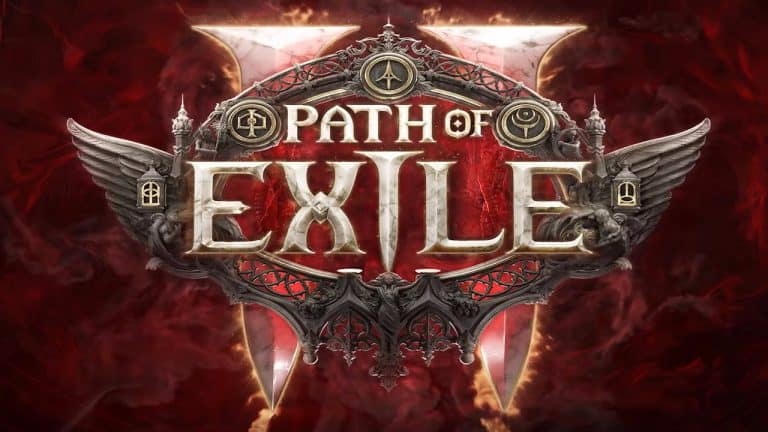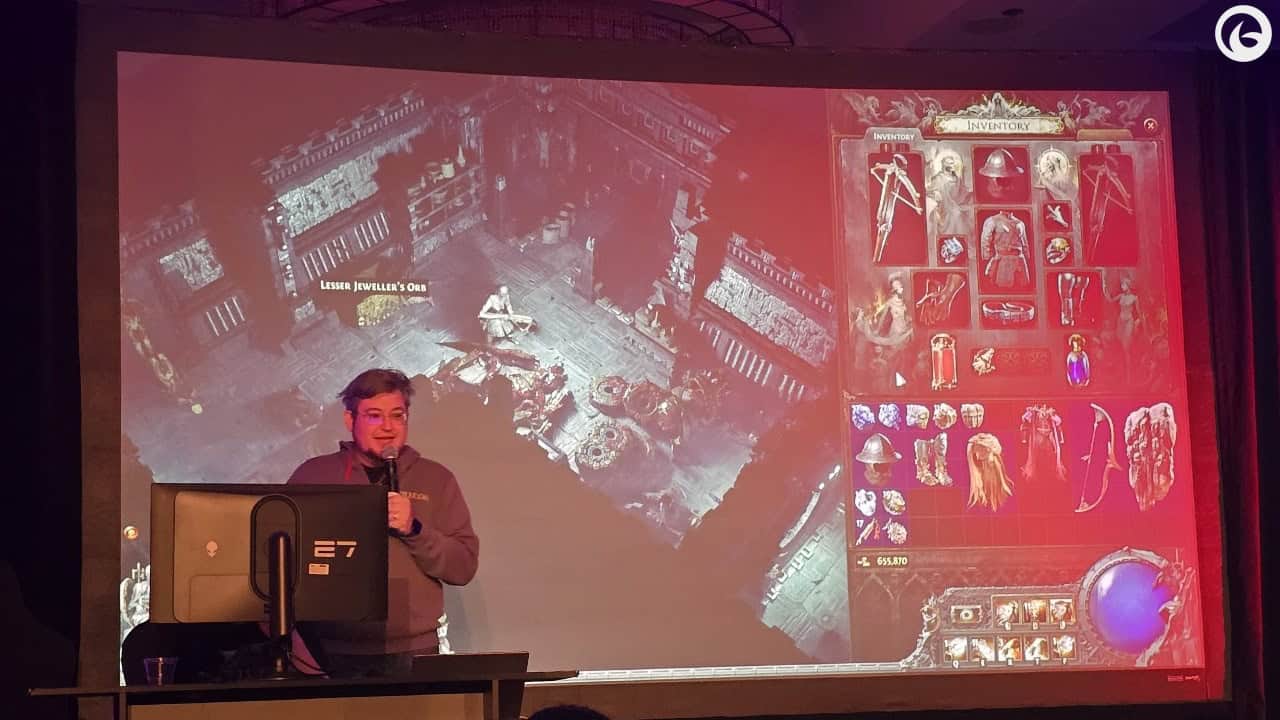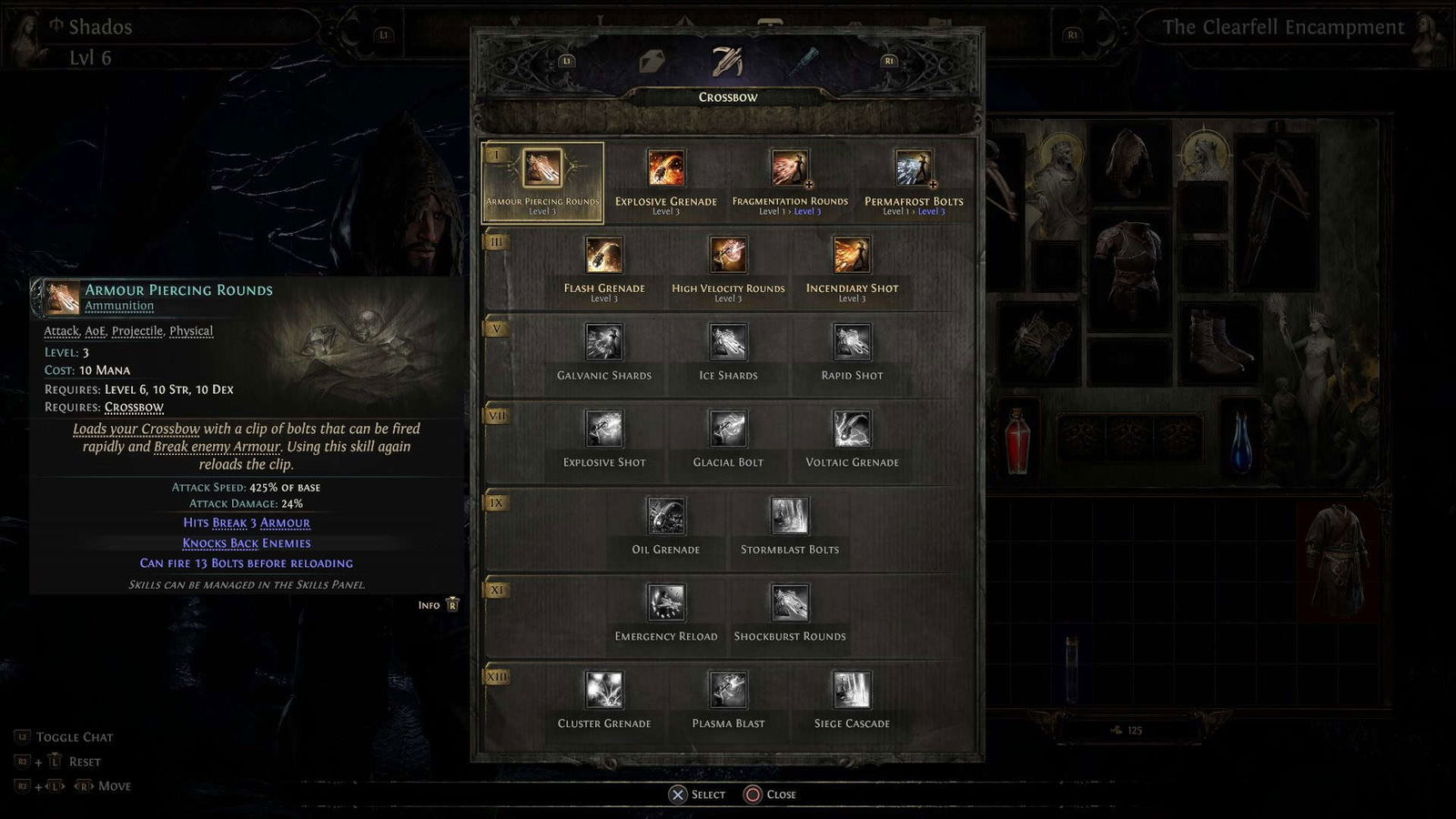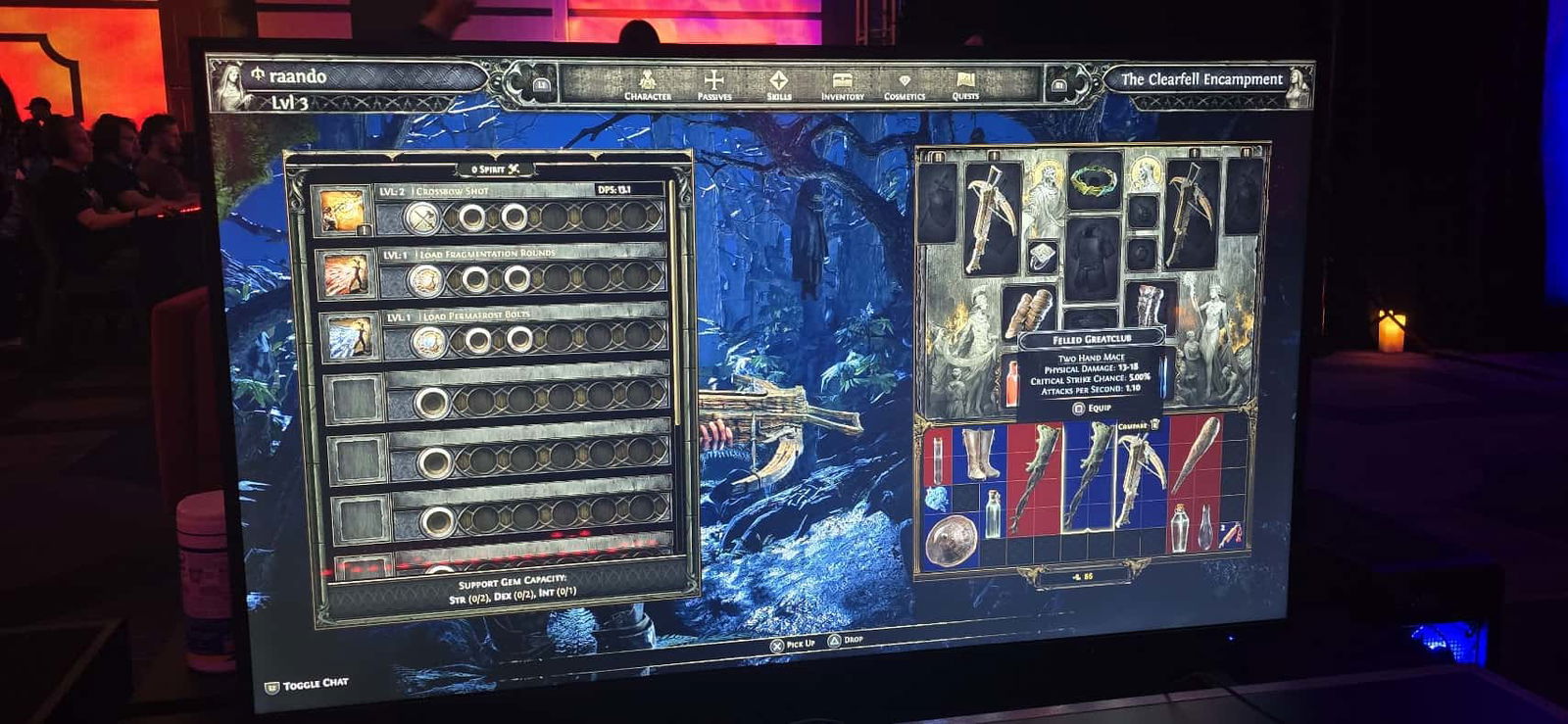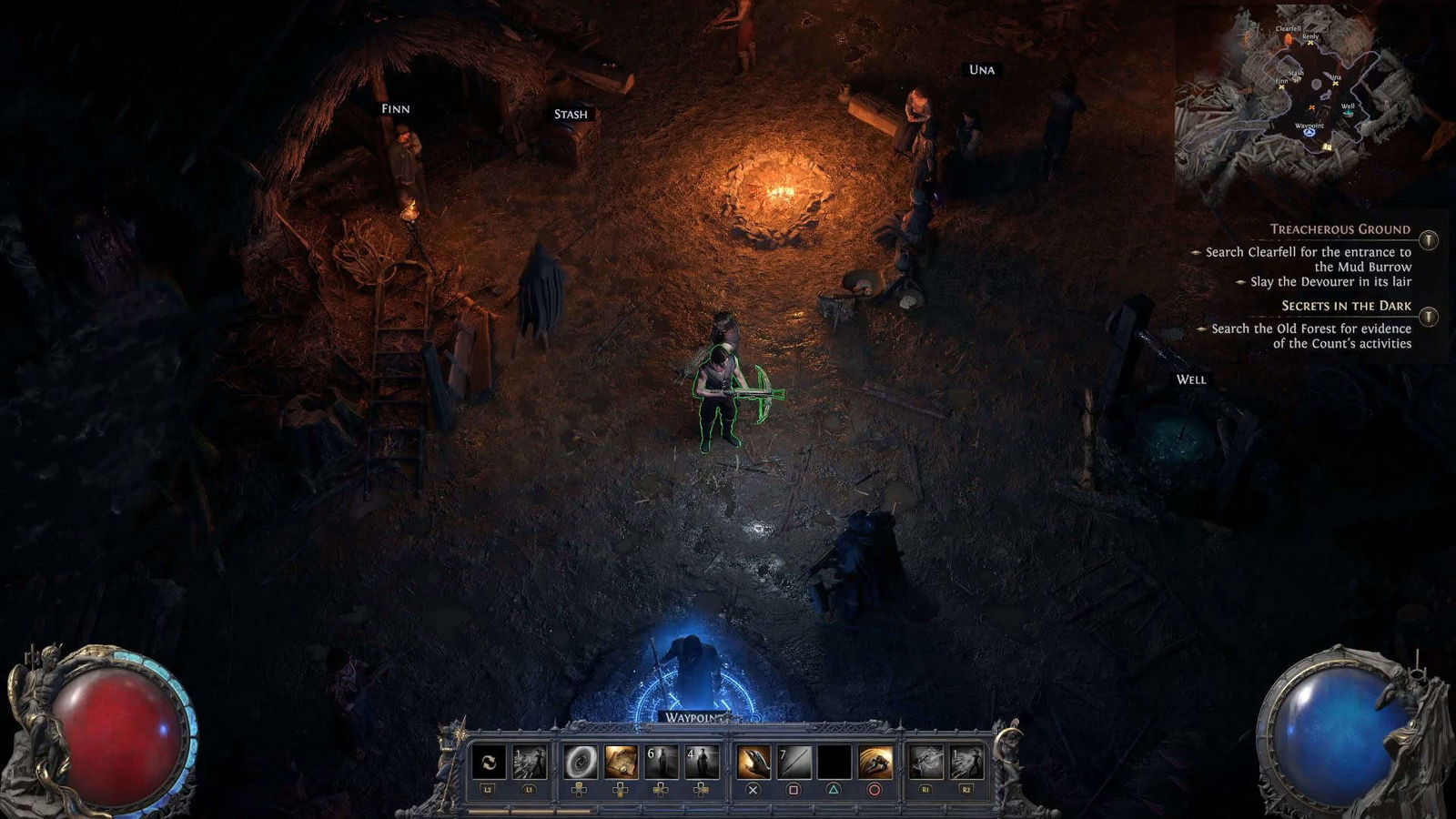A few weeks ago, I was invited to Los Angeles (I still can’t believe it) to attend a special event where I not only had the chance to interview Grinding Gear Games Jonathan Rogers but also got some hands-on time with the company’s upcoming action RPG, Path of Exile 2. While I’ve already shared my thoughts on Path of Exile 2 after experiencing it at Summer Game Fest and PAX West 2024, this time was different. Unlike previous sessions, where a timer counted down my limited playtime and forced me back in line, I had the luxury of four to five uninterrupted hours with the game. And believe me, I made the most of it.
First and foremost, I want to thank the PR team and Grinding Gear Games for making this event possible. Without their invitation, I wouldn’t have had this incredible opportunity, nor would I be able to share just how utterly smitten I am with this game. I know fans of the original Path of Exile are eagerly anticipating this sequel, but after all the time I’ve spent with Path of Exile 2 across various events, I can confidently say this will be an excellent starting point for anyone who wanted to try the first game but felt it was too intimidating.
I also apologize that this is a very long read—let’s just call this my data dump. I wanted to get down and convey everything that I experienced during the event. I know there’s an insanely huge number of players who play Path of Exile, while there are equally the same amount of people who skipped the first game but can’t wait to dive into the second title.
Experiencing Path of Exile 2 With no Restraints
At the event, a massive number of PCs were set up to showcase Path of Exile 2, ensuring that everyone who attended had a chance to try the game. I chose to play on a PC connected to a 65-inch TV, which was primarily intended to demonstrate the game’s couch co-op mode. However, since no one joined my session, I had the full run of the setup for the entire event.
This PC was configured to use a PlayStation 5 DualSense controller, and I played without skipping a beat. I encountered no issues when attacking enemies or navigating menus—everything worked seamlessly. There was also a PC set up with an Xbox controller. When I spoke to the person using that setup, they echoed my experience with the DualSense controller, reporting no problems at all. This shows that Grinding Gear Games has ensured smooth controller integration, making the game enjoyable for PC players who prefer controllers and for console players who rely on them. Seriously, I’m so excited about just how damned good the controller support is in this game. Despite there being access to the traditional point-and-click, as well as the added WASD support, I’ve already convinced myself that I’ll be playing this strictly on a controller.

At the event, several new characters were available to play, bringing the total to six: Warrior, Mercenary, Ranger, Monk, Witch, and Sorceress. All of these characters will be accessible during the Path of Exile 2 early access period. I decided to stick with the Mercenary class, which uses a crossbow for attacking. Playing this character gave me the sensation of an isometric FPS, which made it a lot of fun. The Mercenary relies on different types of ammo such as the standard shots, which give you seven rounds before needing a reload; Permafrost Bolts, a crowd-control shot that applies a freezing effect that eventually freezes enemies briefly stopping them and adding extra damage (yes, this even works against mini-bosses and main bosses); and Fragmentation Rounds, which do more damage but can only be used once before reloading, or adding some oomph being my Armor piercing rounds—these are fantastic for taking down armored enemies.
There are a bunch of other skills, that make the Mercenary a unique class to play, but that’s just one part of playing this class. Sadly, I didn’t get enough time to really get into things, but I do intend to play the Mercenary class once early access starts.
Before I forget, it was also mentioned that some characters can even switch weapon sets on the fly, allowing them to do maximum damage by using them in some slick combos, or using a shield to soak up damage, then lay the smackdown with a meaty hammer.
Additionally, I was able to try out new skills using the updated Gem system—more on that in a moment—that provided stronger abilities through uncut skill gems, which feature a leveling system. For example, there are seven tiers (at least from what I saw), and when inserted into your character’s skill tree, they grant access to progressively more powerful abilities. Alternatively, you can stick with a lower-tier gem and level up specific skills. Total freedom, and I love how much this feels better than PoE 1.
Can I Play Path of Exile 2?
That’s the million-dollar question, and after speaking with GGG, the answer is a resounding yes. The entire game was built around getting new players to jump into the game without the same amount of issues that stemmed from the first game. This was also an issue that GGG had to get around. Making the game so that fans of the original fan won’t complain that this game was made for causal, while also making the game more accessible for players who wanted to play the first game but felt it was too daunting and looking at all the systems and gameplay caused their brains to melt.
For someone who dropped off the original game, and then got multiple hands-on with Path of Exile 2, I felt that the new systems and the gameplay felt great and I wasn’t as lost as I was in PoE 1. It’s still a tough game but it does a great job of explaining systems dropping you in and getting you started.
If you were put off by the first game but have been hyped to play this game, I’m sure you’ll like what this game is about. It’s going to be a great jumping-in point for new players and veterans.
The Gem System Explained
As I mentioned in previous articles, Path of Exile 2 has reworked the gem system from the first game—which I was never a fan of, to be honest—and introduced significant changes that shake things up. First, the skill system is no longer tied to gear slots. Instead, you now have a separate skill tree where you can slot in and customize your abilities as you see fit. Additionally, support gems add another layer of depth by enhancing your skills, but they are no longer directly tied to them.
For example, I could use a support gem with the Mercenary’s Fragmentation Rounds to add a knockback effect or increase the damage of High-Velocity Rounds. Or, if I decide that a certain support gem would be better off with another skill, I can simply pop out that gem and place it into the other skill.
This system offers incredible room for customization, and I’m confident it will challenge traditional min-max strategies. However, acquiring these gems still relies on the unpredictable nature of RNG, keeping things both exciting and rewarding.
What’s even better is the convenience of the new system. While exploring and battling creatures, if you come across a new gem—whether it’s a skill gem or a support gem—you can pause the game and swap it in immediately. This seamless approach simplifies gameplay without sacrificing the depth that fans of the original Path of Exile are used to and love.
There’s a difference between me talking about this change and seeing it in action, and trust me—once the Path of Exile 2 early access drops, players who were hesitant to try the original game will see this system in implementation for themselves and realize it’s a game changer. Especially for those who felt that the gem system originally was too complex.
Respecing Your Character Has Been Overhauled
One of the more drastic features in Path of Exile was the ability to respec the passive skill tree. Typically if you weren’t far enough along in the game, you’d just start over. That’s not the case in Path of Exile 2, as once you reach a certain point within the first few hours, you’ll be able to respec your passive tree… with gold. Refund points from the first game are gone!
Now, you can just give up some gold to make a few changes to your passive skill tree, but from what I’ve seen, it does get rather expensive, and once you get to the endgame, I’d wager it will be extremely expensive. Still, it does give the player more freedom to select skills and then switch them up if you want to take your build in a different direction.
I Need Health and Mana… Flasks
While flasks return in Path of Exile 2, they are handled a bit differently this time around. If you look at the UI, you’ll notice there’s just one Mana and one Health flask, and that’s how it will remain. However, you’re not limited to only one flask, but now you can upgrade not just the amount of health or mana you recover, but also the capacity of your flasks. There are crafting items scattered throughout the world that allow you to upgrade your flasks, though I’m currently drawing a blank on what they’re called—sorry about that!
It doesn’t seem like the most exciting change, but it does help make the UI less cluttered, and your inventory as well.
Don’t Worry, The Passive System Is Still There
For those who played Path of Exile 1 and were worried that the massive passive system would be dumbed down to allow new players to jump in, stop worrying. This passive node system is massive and, according to Grinding Gear Games, features 1,500 nodes. That’s a lot of choices for customizing your character.
Of course, you can also roll back some of those changes, but not without a penalty—it’s going to cost you gold, which you may not have. This makes you understand the importance of making the right decisions. But again, it’s these decisions that ultimately define your character.
The Same Brutal Gameplay from PoE 1
One of the things that PoE fans enjoy about the game is its brutal combat. The game holds no punches and if you don’t pay attention, you’ll see that death screen over and over. Well, I’m happy to report that this extends to PoE 2. Brutal. Unforgiving. And I loved every moment of it. Sure, I wasn’t the biggest Path of Exile player, but if you follow my work here, you know that I’m no stranger when it comes to gives that are unforgiving. That same combat methodology is alive and well in Path of Exile 2.
Deciding to rush forward without making sure you killed the enemies to your rear, will ensure that you’re surrounded by with you frantically using all of your skills to try and stay alive. Fighting bosses was no different, but I did feel like some of the bosses might have been a bit too easy for the most part. That’s not a brag, but it felt like getting to the boss was tougher than the actual boss itself. It could have also been my build, which is also super important in this game.
I had seen some posts on Reddit and Twitter, wondering about how the gameplay would be as they know that GGG was attempting to make Path of Exile 2 a game that newcomers could pick up and play and not be frustrated like they were with the first game. I’m here to tell those people not to worry about anything, the gameplay hasn’t changed. More like the gameplay is tweaked so that new players have a better understanding of what’s happening and how to play.
For example, when you look at the skills available to you, there is a video that will start to play, that will explain how to use that skill. It’s not hand-holding, but it does better than the first game by lowering the entry point by providing more information. It doesn’t alter the gameplay, which again is still tough as nails, but adds a layer of instructional info that was sorely needed in the first game.
But everything that made PoE so good; the combat, randomly generated items and levels, deep character customization, it’s all here and much better.
Visually Blows Path of Exile Out of The Water
One of the things I’ve observed—and I’m sure you have too—is just how visually striking Path of Exile 2 looks. If I told you that both Path of Exile and Path of Exile 2 share the same game engine, you probably wouldn’t believe me. Honestly, I didn’t believe it myself. But when Jonathan Rogers from Grinding Gear Games confirmed it, there was no more doubt.
The two games share the same engine, except Path of Exile 2 benefits from an updated version, thanks to the numerous tweaks the engine has received over time. On top of that, the game is elevated by its fantastical art direction, which makes everything pop—everything. There’s nothing in this game that lacks the artistic flair Grinding Gear Games aimed to implement to showcase its stunning visuals.
The visuals extend to the UI, which is as cluttered as the first game. There are slight improvements, as you can see in the screenshot below. It looks much cleaner, while still conveying the same amount of information.
One of the most striking aspects is the lighting, shadows, particle effects, animation, and updated character models. I can’t look at Path of Exile the same way anymore. There’s a part in the game where thunder fills the entire screen, and it looks stunning. It showcases just how much artistic effort and visual enhancements Grinding Gear Games has poured into this project. The game looks incredible—and it’s not even finished yet.
Handhelds Can Get In On The Fun
During PAX West 2024, it was confirmed that GGG was considering porting Path of Exile 2 to handhelds, specifically the Steam Deck and ASUS ROG Ally. However, the developers present at the event couldn’t provide any specifics at the time. This time around, not only was it confirmed, but I also managed to get some helpful information from Jonathan Rogers. He confirmed that the team has been working on getting the game to run on the Steam Deck, and so far, it performs great in the 40FPS mode. Achieving that level of performance on the Steam Deck sounds fantastic and makes me curious about what we can expect on the ROG Ally/Ally X and the Lenovo Legion Go.
Let’s Talk About Early Access
One of the key highlights of the event was learning more about what will be included in the early access version of Path of Exile 2. As I’ve previously mentioned, all 1,500 nodes in the passive tree will be accessible—but there’s much more to get excited about. Acts 1 through 3, which represent half of the game, will be fully playable. For most players, completing these acts will take around 10–15 hours. That’s a substantial amount of content, with the remaining acts planned for release in 2025 through patches or as part of the eventual full launch.
Regarding playable characters, the Warrior, Mercenary, Ranger, Monk, Witch, and Sorceress will be available, at the start. Ascendancy classes with also be available, but only 2 per class during early access, and you’ll find out how to ascend via a trial found while playing the campaign. In terms of progression, early access will include approximately 50 of the 100 bosses slated for the full game, as well as around 400 unique monsters. Additionally, a new game mode will unlock after completing the first three acts, adding even more replayability.
To gain access to Path of Exile 2 early access, you’ll need to have spent at least $500 on lifetime purchases in the first game. Alternatively, Grinding Gear Games (GGG) will offer Founders’ or Supporter Packs that grant access to the early version of the game. More on how much those will cost will be revealed during an upcoming Path of Exile 2 livestream.
There’s so much more I could share, but I feel it’s best to let GGG unveil those details themselves. Their passion for this project deserves the spotlight, and I wouldn’t want to spoil the excitement for you. Just know that Path of Exile 2 is poised to be a time-consuming, captivating experience. Prepare to say goodbye to your loved ones, take time off work, and lock yourself in your gaming space. Dim the lights and get ready to immerse yourself.
Path of Exile 2 early access begins on December 6, 2024, for PC, PlayStation 5, and Xbox Series X|S.


